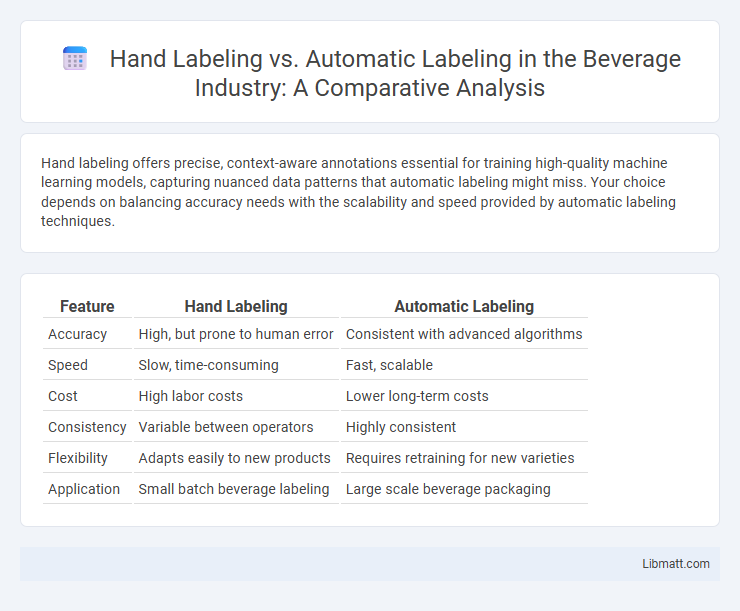Hand labeling offers precise, context-aware annotations essential for training high-quality machine learning models, capturing nuanced data patterns that automatic labeling might miss. Your choice depends on balancing accuracy needs with the scalability and speed provided by automatic labeling techniques.
Table of Comparison
| Feature | Hand Labeling | Automatic Labeling |
|---|---|---|
| Accuracy | High, but prone to human error | Consistent with advanced algorithms |
| Speed | Slow, time-consuming | Fast, scalable |
| Cost | High labor costs | Lower long-term costs |
| Consistency | Variable between operators | Highly consistent |
| Flexibility | Adapts easily to new products | Requires retraining for new varieties |
| Application | Small batch beverage labeling | Large scale beverage packaging |
Introduction to Data Labeling
Data labeling is essential for training accurate machine learning models, involving the assignment of meaningful tags to raw data such as images, text, or audio. Hand labeling offers high accuracy by leveraging human intuition and contextual understanding, making it ideal for complex or nuanced datasets. Automatic labeling employs algorithms to scale labeling efforts efficiently but may require human review to ensure quality, balancing speed and precision for your machine learning projects.
What is Hand Labeling?
Hand labeling involves manually annotating data by human experts to ensure high accuracy and contextual understanding, especially in complex tasks like image recognition or natural language processing. This method helps create high-quality training datasets essential for machine learning models, though it can be time-consuming and costly. Your data's reliability often depends on the thoroughness and expertise applied during the hand labeling process.
What is Automatic Labeling?
Automatic labeling is a process that uses machine learning algorithms to assign labels or annotations to data without human intervention. This technique accelerates data preparation by processing large datasets quickly and consistently, improving efficiency in tasks like image recognition, natural language processing, and speech analysis. Your choice between hand labeling and automatic labeling depends on the required accuracy and scale of your project, as automatic methods may sacrifice some precision for speed.
Accuracy Comparison: Hand vs Automatic Labeling
Hand labeling typically offers higher accuracy due to human judgment and contextual understanding, especially in complex or nuanced datasets. Automatic labeling, powered by machine learning algorithms, provides scalability but may suffer from errors like misclassification or inconsistent labeling in ambiguous cases. Hybrid approaches combining both methods can optimize accuracy by leveraging human oversight to correct automated outputs.
Speed and Scalability Analysis
Automatic labeling significantly outperforms hand labeling in speed, processing vast datasets in minutes that would take humans hours or days to complete. Scalability is a key advantage of automatic labeling, enabling your projects to grow without proportional increases in labor costs or time. Hand labeling may provide higher accuracy for niche tasks, but it lacks the efficiency and scalability critical for large-scale data annotation.
Cost Efficiency: Manual vs Automated Methods
Manual hand labeling incurs significant labor costs and time consumption due to the need for human annotators to accurately process datasets, making it less cost-effective for large-scale projects. Automated labeling leverages machine learning algorithms to rapidly generate annotations with minimal human intervention, substantially reducing operational expenses and accelerating data preparation. Although initial setup and algorithm training may require investment, automated methods ultimately offer superior cost efficiency over manual labeling in high-volume applications.
Human Bias vs Algorithmic Bias
Hand labeling often introduces human bias caused by subjective judgments, cultural perspectives, and inconsistent labeling standards, which can impact the quality and fairness of datasets. Automatic labeling relies on algorithmic bias, where pre-existing biases in training data or model design influence the labeling process, potentially amplifying systematic errors. Your choice between these methods should consider the trade-offs in bias types to achieve balanced and accurate data annotation.
Best Use Cases for Hand Labeling
Hand labeling excels in scenarios requiring high accuracy and domain expertise, such as medical image annotation or legal document classification. It is ideal for training data in complex tasks where nuance, context, and subtle variations considerably impact model performance. Manual labeling also proves beneficial when datasets are small or contain ambiguous samples that automatic labeling tools might misclassify.
When to Choose Automatic Labeling
Automatic labeling is ideal when dealing with large datasets requiring quick annotation, as it significantly speeds up the process compared to manual efforts. You benefit from reduced labor costs and consistent labeling quality, especially in applications like image recognition or natural language processing. This method suits scenarios where accuracy can be balanced with speed and scalability, relying on pre-trained models or algorithms to annotate data efficiently.
Combining Hand and Automatic Labeling: Hybrid Approaches
Hybrid approaches in data annotation leverage the precision of hand labeling with the scalability of automatic labeling, enhancing dataset quality and efficiency. Utilizing human expertise to verify and correct automatically generated labels reduces errors in training data, significantly boosting model performance in applications like image recognition and natural language processing. This combination optimizes resource allocation, balancing speed and accuracy in large-scale machine learning projects.
Hand labeling vs automatic labeling Infographic

 libmatt.com
libmatt.com